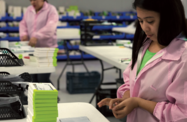Growing rice consumption in the Philippines has created a host of challenges and opportunities for stakeholders, as an ongoing lack of mechanisation and post-harvest inefficiencies have prevented the government from meeting its goal of achieving rice self-sufficiency. Although palay (unhusked rice) production has made steady gains in recent years, farmers continue to face high costs due to the lack of technological uptake. This has led to heavy importation, with the current administration recently awarding two high-value contracts to foreign firms for buffer stock supply. Mechanisation, most likely to be achieved through private sector investment, represents a promising means of increasing rice production in the future.
Comprising primarily coconut, sugarcane and rice crops, in addition to an expanding livestock segment, the agricultural sector in the Philippines showed slow growth in 2013, expanding by 1.15% to reach P1.5tr ($35.3bn) for the year. According to the Philippine Bureau of Agricultural Statistics, crop production, which makes up 51% of total agricultural production, expanded by 0.09%. Rice production outperformed the crop sector average to grow by 2.26% in 2013, reaching a record 18.44m tonnes.
An appetite for imports
However, consumption has been rising faster than production, growing from 116 kg per capita in 2004 to 128 kg in 2008, before dropping back to 117 kg in 2012, and necessitating regular imports, which have grown from 707,000 tonnes in 2011 to more than 1m tonnes in 2012, according to the Philippine Statistics Authority. Meanwhile, the US Department of Agriculture estimated that the Philippines would import around 2m tonnes of rice in 2013 and 2014, including 500,000 tonnes of smuggled rice imports, while the UN’s Food and Agriculture Organisation expects the country to import 1.2m tonnes of rice in 2014.
Consequently, the country’s National Food Authority (NFA) has allocated P17.18bn ($398.6m) for the importation of 800,000 tonnes of rice in 2014. State-owned Vietnam Southern Food Corporation (Vinafood 2) won a contract to supply 600,000 tonnes, while the remaining 200,000 tonnes will be supplied by the Vietnam Northern Food Corporation (Vinafood 1). Vinafood 2 agreed pricing per tonne of $436.50, $437.75 and $439.25 for three lots of 200,000 tonnes each, while Vinafood 1 agreed pricing per tonne of $436 and $439 for two lots of 100,000 tonnes each. The two companies beat bids from a host of interested traders, including Louis Dreyfus Commodities, Thai Hua and Singsong Hongkong.
The nation’s Food Staples Sufficiency Programme (FSSP) 2011-16 aims to increase efficiency in food production, with rice self-sufficiency identified as a key target. The country’s failure to achieve rice self-sufficiency by 2013 has prompted the government to encourage greater private investment in the sector. In April 2014, the Philippine secretary of agriculture, Proceso Alcala, told local media that rice farmers needed more government help to reduce the cost of paddy production and boost competitiveness relative to Thailand and Vietnam.
Alcala said rice farmers were not prepared for the anticipated economic integration of the Association of South-east Asian States in 2015, as a result of their high production costs stemming from the lack of mechanisation and post-harvest inefficiencies. For instance, 16.5% of harvested rice is lost due to a lack of adequate drying facilities alone.
The government has increased its efforts to tackle production challenges in recent years, launching large, well-funded projects aimed at improving irrigation and mechanisation. The National Irrigation Administration received its largest-ever budget of P25bn ($592.5m) in 2012, double its 2011 funding, which allowed a Department of Agriculture programme to increase the number of annual rice harvests from four to five.
At the same time, the government has worked to create larger and more efficient land blocks from small adjoining plots, while simultaneously increasing the use of less expensive organic and hybrid fertilisers, under the Organic Agriculture Act of 2010.
Catching up with the neighbours
Nevertheless, rice production remains expensive, presenting new opportunities for private sector investment. According to PhilRice, the cost of paddy production in the Philippines is about $222 per tonne, compared to just $111 per tonne in Vietnam, and $178 per tonne in Thailand. PhilRice reports that labour comprises about 50% of production costs in the Philippines, with access to machinery, adequate post-harvest facilities, and non-restrictive loans identified as potential solutions to this cost challenge.
Several nations have taken note, including most recently in April 2014 when Wu Zhengping, the Chinese economic and commercial counsellor to the Philippines, told the Philippines Chamber of Commerce and Industry that Chinese investors were keen to expand their activities in rice paddy mechanisation.
At the same time, successful new mechanisation programmes for other crops, such as the corn mill prototype launched in May 2014 by the Philippine Centre for Postharvest Development and Mechanisation (Philmech), have raised hopes that future mechanisation efforts could be applied to the rice sub-sector.
Follow Oxford Business Group on Facebook, Google+ and Twitter for all the latest Economic News Updates. Or register to receive updates via email.

